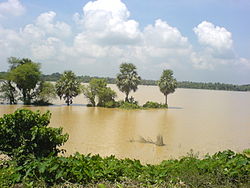Climatology/The Monsoon
The word ‘monsoon’ has been derived from the Arabic word Mausim which means season. The climate of India is described as the monsoon type. The monsoon word was used by Arab traders to describe a system of seasonal reversal of winds along the shores of the Indian Ocean. Monsoons are especially prominent within the tropics on the eastern sides of the great landmass, but in Asia, it occurs outside the tropics in China, Korea and Japan. In Asia, this type of climate is found mainly in the south and the southeast.
Origin of Monsoon
[edit | edit source]Monsoon is a complex meteorological phenomenon. Experts of meteorology have developed a number of concepts about the origin of the monsoon:
Thermal Concept
[edit | edit source]Halley proposed the thermal concept. According to this hypothesis, monsoons are the extended land breeze and sea breeze on a large scale. During winter the huge landmass of Asia cools more rapidly than the surrounding oceans with the result that a strong high pressure centre develops over the continent. The pressure over adjacent oceans is relatively lower. As a consequence the pressure-gradient is directed from land to sea. In summer the temperature and pressure conditions are reversed. The huge landmass of Asia heats quickly and develops a strong low pressure centre.
Criticism of Halley's hipothesis includes:
- It fails to explain the intricacies of monsoon such as sudden burst of monsoon, breaks in monsoon, spatial and temporal distribution of monsoon.
- The low pressure areas are not stationary.
- The rainfall is not only convectional but a mix of orographic, cyclonic and convectional rainfall.
Regional aspects of monsoons
[edit | edit source]The regional aspects of monsoons are as follows:
- Summer monsoon or SW monsoon in India and Southeast Asia.
- The Australian NW monsoon.
- The West African monsoon.
- The winter monsoon over Malaysia and Indonesia.
Recent Concept of the Origin of Indian Monsoon
[edit | edit source]
After the Second World War, the upper atmospheric circulation has been studied significantly. It is believed that the differential heating of sea and land alone can’t produce the monsoon circulation. Recent concepts of monsoons heavily on the role of:
- Himalayas and Tibetan plateau as a physical barrier and a source of high-level heat.
- Circulation of upper air jet streams in the troposphere.
- Existence of an upper air circumpolar whirl over north and south poles in the troposphere.
- The occurrence of ENSO (El-Nino and Southern Oscillation) in the South Pacific ocean.
- Walker cell in Indian Ocean.
- Indian Ocean Dipole.
The Onset of the Monsoon
[edit | edit source]Out of a total of 4 seasonal divisions of India, monsoon occupy 2 divisions:
- The southwest monsoon season: Rainfall received from the southwest monsoons is seasonal in character, which occurs between June and September.
- The retreating monsoon season: The months of October and November are known for retreating monsoons.
Onset of the South-West Monsoon
[edit | edit source]The Monsoon, unlike the trades, are not steady winds but are pulsating in nature, affected by different atmospheric conditions encountered by over the warm tropical seas. The duration of the monsoon is between 100 and 120 days from early June to mid-September. The location of ITCZ shifts north and south of the equator with the apparent movement of the Sun. During the month of June, the sun shines vertically over the Tropic of Cancer and the ITCZ shifts northwards. The southeast trade winds of the southern hemisphere cross the equator and start blowing in southwest to northeast direction under the influence of Coriolis force. These winds collect moisture as they travel over the warm Indian Ocean. In the month of July, the ITCZ shifts to 20°-25° N latitude. It located in the Indo-Gangetic Plain and the south-west monsoons blow from the Arabian Sea and the Bay of Bengal. These winds approach the land, and their southwesterly direction is modified by the relief and thermal low pressure over northwest India.
The monsoon approaches the Indian landmass in two branches:
- The Arabian Sea branch - The monsoon winds originating over the Arabian Sea.
- The Bay of Bengal branch - The Arakan Hills along the coast of Myanmar deflect a big portion of this branch towards the Indian subcontinent. The monsoon, therefore, enters West Bengal and Bangladesh from south and southeast instead of from the south-westerly direction.

Retreating Monsoon Season
[edit | edit source]The retreating southwest monsoon season is marked by clear skies and rising temperatures.The land is still moist.the conditions of high temperature and humidity, the weather becomes rather oppressive. This is commonly known as the October heat. In the second half of October, the mercury begins to fall rapidly, particularly in northern India. The weather in the retreating monsoon is dry in north India but it is associated with rain in the eastern part of the Peninsula. Here, October and November are the rainiest months of the year. The widespread rain in this season is associated with the passage of cyclonic depressions which originate over the Andaman Sea. These tropical cyclones are very destructive. A bulk of the rainfall of the Coromandel Coast is derived from these depressions and cyclones.


